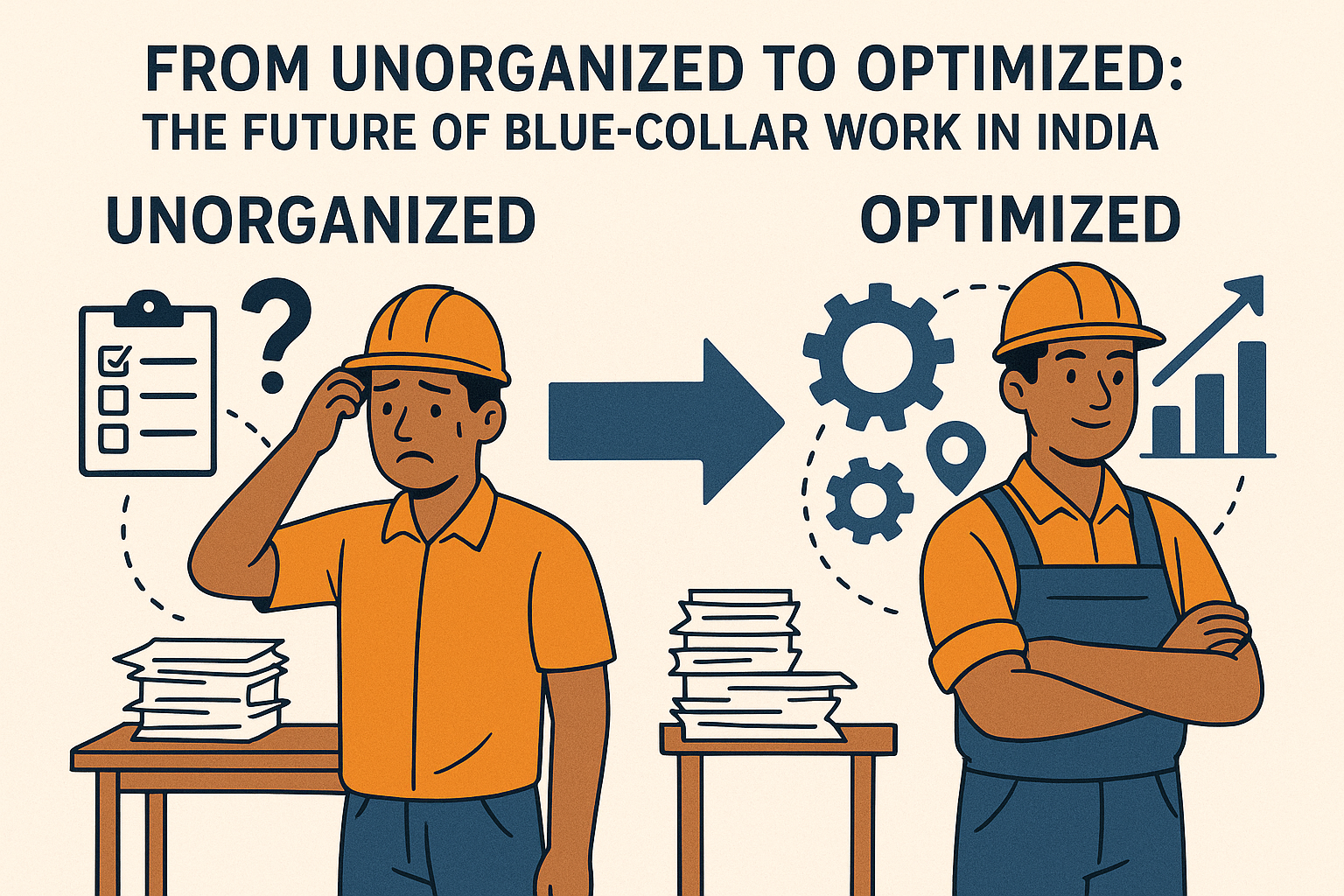Introduction
India’s economy is undergoing a profound transformation, driven by industrialization, digitization, and a renewed focus on manufacturing and infrastructure. At the heart of this transformation lies a vital but often overlooked segment of the workforce: blue-collar workers. Traditionally employed in the unorganized sector, these workers are now at the center of a silent revolution that is reshaping labor dynamics across the country. As we stand on the cusp of a new era, it is essential to understand how blue-collar work is evolving from unorganized to optimized, and what the future holds.
The Backbone of India’s Workforce
Blue-collar workers encompass a wide range of professions—from factory workers and electricians to delivery personnel and construction laborers. According to the McKinsey Global Institute, by 2030, nearly 70% of the projected 90 million new jobs in India will be in blue-collar sectors. These roles will primarily emerge in manufacturing, logistics, construction, and the service industry, forming the backbone of India’s economic engine.
Despite their critical contribution, blue-collar workers have historically remained in the shadows—characterized by informal employment, lack of job security, poor working conditions, and limited social protections. However, with the convergence of technology, government policy, and changing industry needs, the traditional blue-collar ecosystem is being reimagined.
Drivers of Change
1. Formalization of the Workforce
Government schemes like the Pradhan Mantri Shram Yogi Maandhan (PM-SYM), the expansion of Employee State Insurance (ESI), and the Unified Shram Suvidha Portal have made significant strides in bringing blue-collar workers under formal employment frameworks. Additionally, the introduction of labor codes and initiatives to digitize worker records are fostering transparency and accountability.
2. Rise of Gig and Platform Economies
The proliferation of digital platforms like Urban Company, Zomato, Swiggy, and WorkIndia is revolutionizing the way blue-collar labor is hired and managed. These platforms offer structured work opportunities with performance tracking, digital payments, and some degree of social security. They are playing a crucial role in formalizing employment, particularly among urban youth.
3. Technology and Automation
Automation and Industry 4.0 technologies such as IoT, robotics, and AI are transforming manufacturing and logistics. While there are concerns about job displacement, technology is also creating demand for semi-skilled technicians and operators who can manage and maintain automated systems. The upskilling of workers through vocational training and certification programs is therefore becoming essential.
4. Government and Private Sector Collaboration
Public-private partnerships are creating robust skilling ecosystems. Initiatives like Skill India, PMKVY (Pradhan Mantri Kaushal Vikas Yojana), and the establishment of Industrial Training Institutes (ITIs) are bridging the skills gap. Corporates are also investing in training programs to ensure a steady supply of job-ready blue-collar talent.
5. Changing Societal Perceptions
There is a gradual but notable shift in how blue-collar jobs are perceived. With improved pay scales, performance incentives, and professional training, these jobs are beginn ing to be seen as viable career paths rather than stop-gap solutions. Recognition and dignity at the workplace are now being emphasized.
Emerging Trends
1. Increased Female Participation
Women are slowly but steadily entering traditionally male-dominated blue-collar roles. Sectors like healthcare, retail, and electronics assembly are seeing higher female participation, driven by inclusive hiring practices and a focus on workplace safety.
2. Focus on Health and Well-being
Employers are recognizing the importance of mental and physical health among workers. Health insurance, wellness programs, and ergonomic work environments are being introduced to enhance productivity and reduce attrition.
3. Data-Driven Workforce Management
Companies are leveraging data analytics to optimize workforce deployment, track performance, and forecast labor requirements. Predictive analytics is also being used to improve occupational health and safety standards.
4. Decentralized Work Opportunities
With improved internet connectivity and logistics networks, work is becoming increasingly decentralized. Workers no longer need to migrate to metro cities; instead, employment hubs are emerging in Tier-2 and Tier-3 towns.
Challenges Ahead
While the future looks promising, several challenges remain. Skill mismatches, lack of digital literacy, resistance to change, and limited access to formal credit and housing continue to plague blue-collar workers. Moreover, the informal sector still employs a majority of these workers, and transitioning them to formal setups requires coordinated efforts from multiple stakeholders.
The Road Ahead
To truly optimize the blue-collar workforce, a multi-pronged approach is essential:
- Policy Reforms: Simplified labor laws and social security schemes must be effectively implemented and monitored.
- Skill Development: Continuous investment in vocational training, apprenticeships, and certification programs is critical.
- Technological Integration: Adoption of worker management platforms and digital tools should be encouraged across industries.
- Financial Inclusion: Access to banking, insurance, and credit services can empower workers and reduce vulnerability.
- Employer Responsibility: Businesses must foster inclusive and respectful workplaces, provide growth opportunities, and ensure fair compensation.
Conclusion
The journey from unorganized to optimized blue-collar work in India is not just an economic imperative—it is a social and developmental necessity. By harnessing the power of technology, skilling, and policy innovation, India can build a future where blue-collar workers are not just laborers, but valued contributors to national growth. The onus lies on all stakeholders—government, industry, civil society, and workers themselves—to collaborate and ensure that this transformation is inclusive, sustainable, and truly empowering.
As India marches toward becoming a $5 trillion economy, the optimization of its blue-collar workforce will be a defining pillar of success. The time to act is now.




